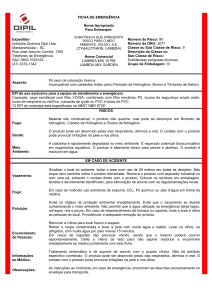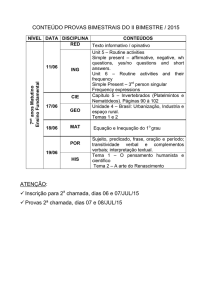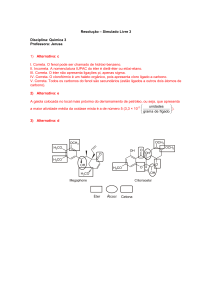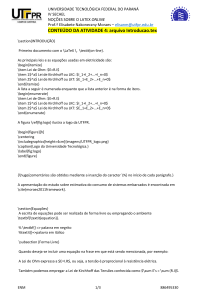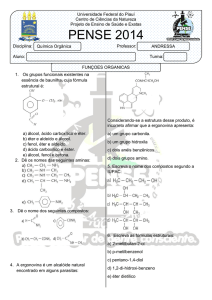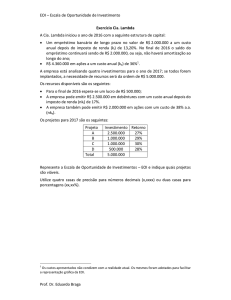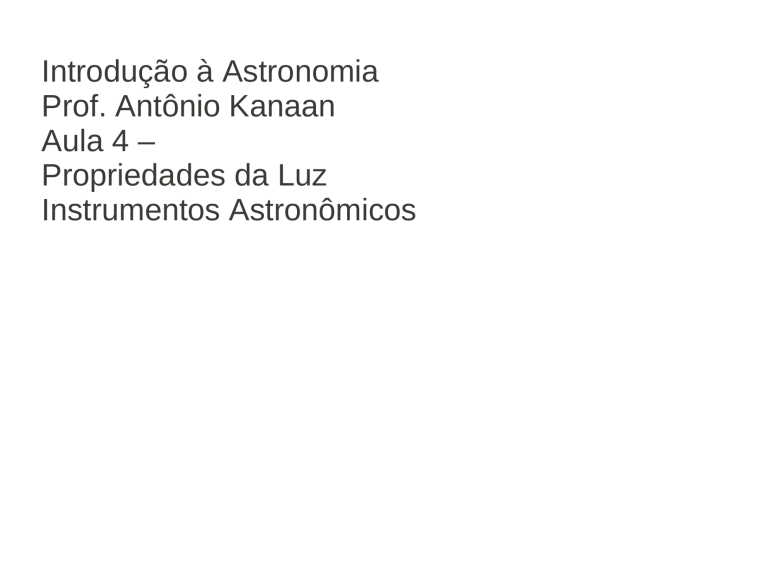
Introdução à Astronomia
Prof. Antônio Kanaan
Aula 4 –
Propriedades da Luz
Instrumentos Astronômicos
Créditos:
A maioria das figuras da aula de hoje vêm de:
1) Chaisson
2) Hypershysics
(http://hyperphysics.phy-astr.gsu.edu/hbase/hframe.html)
Informação vem em forma:
1 – luz (ondas eletromagnéticas)
2 – ondas gravitacionais
3 - neutrinos
O que é a luz?
Onda? Partícula? como este é um curso de astronomia e não de
física não discutiremos muito sobre a natureza da luz, que é um
assunto fascinante.
História curta:
Newton - defensor da teoria corpuscular
Huygens – defensor da teoria ondulatória
Difração de uma onda de água em um tanque
Difração da luz de
um laser ao passar
por um orifício
quadrado.
O éter:
se onda se propaga como?
inventou-se o éter.
por fim se provou que o éter não existe (experiência de
Michelson-Morley)
“provou-se” mais ainda: que c=constante
e por fim acabou se provando o que “não se queria”: que a luz
também é uma partícula, daí começa a grande revolução da
mecânica quântica.
efeito fotoelétrico:
O éter:
se onda se propaga como?
inventou-se o éter.
por fim se provou que o éter não existe (experiência de
Michelson-Morley)
“provou-se” mais ainda: que c=constante
e por fim acabou se provando o que “não se queria”: que a luz
também é uma partícula, daí começa a grande revolução da
mecânica quântica.
efeito fotoelétrico:
Só há geração de elétrons quando a luz tem frequência maior que um determinado patamar
Radiação de Corpo Negro: O Termômetro astronômico
Lei de Wien
Lei de Steffan-Boltzmann
Luminosidade total
Lei de Wien:
λT = 2.9x10^7 A K
Lei de Steffan Boltzmann:
F = σT^4
L=A*F
A = 4πR^2
ESPECTROSCOPIA:
Emissão e absorção de fótons
O átomo do hidrogênio
O modelo de Bohr
Espectro de algumas estrelas
“comuns”
Notem para as estrelas de O5
até G5 a presença de linhas de
hidrogênio.
Espectro do Sol
Esta é uma imagem do
espectro solar. As cores
indicam a região do
espectro, e apesar de
falsas indicam
corretamente a posição
no espectro visível.
As manchas escuras são
as linhas de absorção
(leis de Kirchoff logo
adiante)
Leis de Kirchoff:
1 – contínuo – corpo denso e opaco
2 – emissão – gás fino
3 – absorção - gás fino iluminado por tras por algum outro
objeto
O efeito Doppler
O efeito Doppler:
For waves that travel through a medium (sound, ultrasound, etc...) the relationship
between observed frequency f' and emitted frequency f is given by:
f' = \left( \frac{v}{v \pm v_s} \right) f \,
where
v \, is the speed of waves in the medium (in air at T degrees Celsius, this is 332 +
0.59T m/s)
v_s \, is the velocity of the source (the thing emitting the sound)
For waves that travel at the speed of light, such as radio waves, the relationship between
observed frequency f' and emitted frequency f is given by:
Change in frequency Observed frequency
\Delta f=\frac{fv}{c}=\frac{v}{\lambda}
f'=f+\frac{fv}{c}
where
f \, is the transmitted frequency
v \, is the velocity of the transmitter relative to the receiver in meters/second: positive
when moving towards one another, negative when moving away
c \, is the speed of light in a vacuum \left(3\cdot10^8\right) m/s
\lambda \, is the wavelength of the transmitted wave subject to change
For motion along the line of sight
If the observer and the source are moving directly away from each other with velocity
v\,, the observed frequency f_o\, is different from the frequency of the source f_e\, as
f_o = \sqrt{\frac{1-v/c}{1+v/c}}\,f_e
where c\, is the speed of light.
The corresponding wavelengths are related by
\lambda_o = \sqrt{\frac{1+v/c}{1-v/c}}\,\lambda_e
and the resulting redshift z\, can be written as
z + 1 = \frac{\lambda_o}{\lambda_e} = \sqrt{\frac{1+v/c}{1-v/c}}
In the non-relativistic limit, i.e. when v \ll c\,, the approximate expressions are:
\frac{\Delta f}{f} \simeq -\frac{v}{c} \qquad \frac{\Delta \lambda}{\lambda} \simeq
\frac{v}{c} \qquad z \simeq \frac{v}{c}
Note: In all the expressions in this section it is assumed that the observer and the
source are moving away from each other. If they are moving towards each other, v\,
should be taken negative.

